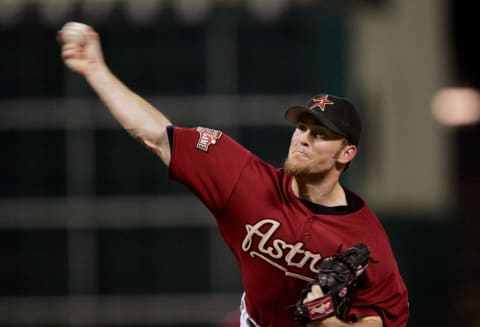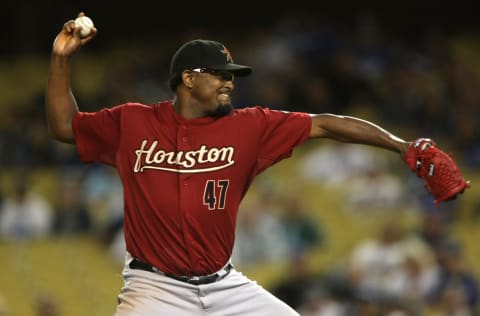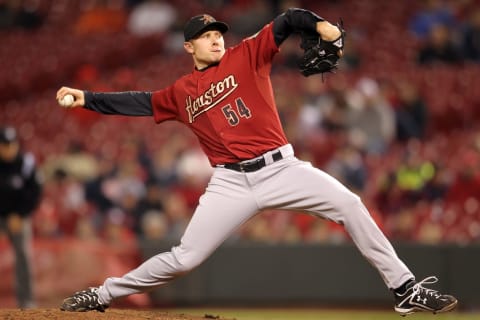Astros: Inconsistent closers since Pujols home run

The Astros have mostly lacked a dominant closer since that fateful night in 2005.
There are certain moments in sports that get burned into your memory. They don’t come around very often, but they stick with you forever. The common thread is they usually affect your soul; they either lift it up in joy or crush it in defeat. Astros fans are no stranger to this.
It was October 17, 2005 when one such moment occurred. The Astros were playing Game Five of the NLCS at Minute Maid Park against the Cardinals, holding a 3-1 lead in the series and looking to advance to the first World Series in franchise history. But it was not to be on this night.
With the Astros leading 4-2 in the ninth inning, shutdown closer Brad Lidge was on the mound. He struck out the first two batters he faced, but then gave up a single to David Eckstein and a walk to Jim Edmonds. That brought the league’s most feared slugger to the plate in Albert Pujols.
On an 0-1 count, Lidge hung a slider right in the middle of the plate, and Pujols got every bit of it. The ball soared over the train tracks in left field and is probably still in orbit to this day. It gave the Cardinals a 5-4 lead and the win, though the Astros would win Game Six to advance to their first World Series.
Still, the home run marked a turning point for the franchise. Lidge simply was never the same after it, and the Astros seemingly haven’t had a shutdown closer like they had for most of the decade prior to it. It was one moment that still affects the team to this day.

Brad Lidge
Lidge enjoyed a pair of dominant seasons in 2004 and 2005, picking up where Billy Wagner left off. He put up a 1.90 ERA in 2004, striking out a ridiculous 157 batters in 94.2 innings of relief. He notched 42 saves with a 2.29 ERA in 2005, giving the Astros plenty of confidence in him leading up to that fateful homer.
After it, though, that confidence waned. Lidge struggled through the 2006 season, posting a 1-5 record and 5.28 ERA. He still made 78 appearances and saved 32 games, and he still struck out more than 100 batters, but he just wasn’t the same pitcher.
Lidge’s rates of hits, walks and home runs allowed spiked in 2006. His strikeout-to-walk ratio plummeted, and he set a career high in wild pitches thrown. In fact, he gave up twice as many homers in 2006 as he did the year prior.
His 2007 season was a little better, as his ERA improved to 3.36 over 66 appearances. He only saved 19 games, and his peripheral numbers weren’t that much better than his 2006 numbers. Ultimately it would prove to be his final season in a Houston uniform.
The Astros traded Lidge to the Phillies after the 2007 season along with Eric Bruntlett and received Michael Bourn, Michael Costanzo and Geoff Geary in return. Lidge would bounce back to put up an incredible 2008 season, notching 41 saves with a 1.95 ERA and recording the final out of the World Series.
He had an awful 2009 season before posting good numbers in limited appearances in 2010 and 2011. He made his last major league appearance in 2012 with the Nationals. The Astros also made another trade after the 2007 season which gave them the closer they were looking for.

Jose Valverde
Papa Grande was coming off a 2007 season with Arizona in which he led the majors in saves with 47 and finished sixth in the Cy Young Award voting. He was heading into his age-30 season with two years of team control remaining. He’d established himself as an All-Star closer, and the Astros had a clear need for one.
The Astros traded Chris Burke, Chad Qualls and J.C. Gutierrez to the Diamondbacks to get Valverde. His first season with Houston in 2008 was largely a success, as he led the major leagues in games finished (71) and led the league in saves (44). His 3.38 ERA wasn’t overly impressive, but he even garnered a little MVP consideration.
He missed a little time with injury in 2009, but still appeared in 52 games and posted a sterling 2.33 ERA and 25 saves. His hit and home run rates improved from the prior season, but his strikeout and walk rates were trending in the wrong direction. Presumably with that in mind, the Astros let him leave in free agency.
Valverde signed with the Tigers as a free agent and had some success, including a 2011 season in which he led the league in appearances, games finished and saves, finishing fifth in the Cy Young voting. His last major league appearance came with the Mets in 2014.
In two seasons, Valverde gave the Astros 69 saves, a 2.93 ERA and 10-5 record. He may not have quite matched the Wagner and peak Lidge numbers, but he was more than capable of handling the role. In the ensuing seasons after his departure, the Astros would not come close to replicating that stability.

The Committee Years
For several years immediately before and during the big rebuild, the Astros didn’t have just one guy who was always the closer. Rather, they cycled through a number of guys who ended up saving a handful of games each.
The team signed Brandon Lyon as a free agent prior to the 2010 season, and he saved 20 games with a 3.12 ERA that year. He had a disastrous 2011 before rebounding in 2012. He was included in the July 2012 trade that sent J.A. Happ to Toronto and brought Joe Musgrove and others to Houston.
Matt Lindstrom actually led the Astros in saves in 2010 with 23, though his 4.39 ERA was hardly noteworthy. He’d been acquired in a trade with the Marlins prior to the season, but lasted only one year. Houston shipped him to Colorado following the 2010 season.
Though he established himself an a top closer later after his Houston tenure, Mark Melancon got his first 20 career saves with the Astros in 2011. He put up solid numbers that year, with a 2.78 ERA and 8-4 record over 71 appearances. He was traded to Boston after the season in exchange for Jed Lowrie and Kyle Weiland.
After making 66 starts for the Astros in 2010-2011, Brett Myers was transitioned to the bullpen prior to the 2012 season. He saved 19 games with a 3.52 ERA before being traded to the White Sox. A player to be named later the Astros received in that trade was none other than Chris Devenski.
Wilton Lopez took over as closer and saved 10 games following Myers’ trade. He was in his third of three strong years in the Houston bullpen, but he was traded to the Rockies after the season. Free agent signing Jose Veras posted 19 saves in 2013 before being flipped to the Tigers at the trade deadline.
Chad Qualls led the team with 19 saves in 2014, his second stint with the club. The Astros went this entire period (2010-2014) without having a player record 30 saves in any season. Their return to contention in 2015 brought that streak to an end.

Return to Contention
Though the Astros have posted winning records in each of the past five seasons and have made the playoffs in four of those, one thing to note is the lack of a consistent closer in that time frame. It’s something the team continues to struggle with today.
Part of what got the Astros to the playoffs in 2015 was a revamped bullpen led by veteran Luke Gregerson. He was largely effective and served as the closer in his first season, saving 31 games with a 3.10 ERA in 64 appearances.
Prior to the 2016 season, the Astros sent former No. 1 overall pick Mark Appel and three others to Philadelphia for Ken Giles. His first season in Houston was up and down, and he and Gregerson split the closing duties along with Will Harris. Neither player posted more than 15 saves that year.
More from Climbing Tal's Hill
- Just how much better is the Houston Astros playoff rotation than the rest?
- Houston Astros: A Lineup Change to Spark Offense
- Astros prospect Hunter Brown throws 6 shutout innings in debut
- Always faithful Astros World Series champion Josh Reddick defends the title
- Michael Conforto declines Astros’ 2-year, $30 million offer
Giles’ 2017 season was much better as the Astros captured their first World Series title. He saved 34 games with a 2.30 ERA, dramatically reducing his hit and home run rates. But 2018 was a different story as he posted a 4.99 ERA with 12 saves before being shipped off to Toronto in exchange for Roberto Osuna.
Hector Rondon actually led the Astros in saves in 2018 with 15, while Osuna chipped in 12 with a 1.99 ERA down the stretch. The idea in acquiring an established closer like Osuna was to solve the continuity issues the team had since Valverde’s departure, and in that respect they succeeded.
But Osuna is a lightning rod and probably always will be thanks to his off-field issues. On the field, he posted a 2.63 ERA in 2019 and led the league with 38 saves. He also led the majors in games finished, though his first half (1.95 ERA) was better than his second half (3.54 ERA).
Osuna’s postseason performance with the Astros has been less than ideal. He got rocked in the 2018 ALCS, and he was scored upon in all three postseason series in 2019. Until he can improve upon that, he will always be viewed as at least one step below the Wagner/peak Lidge combination.
Next. Astros options with both catchers free agents. dark
Still, if the Astros are able to retain Osuna for at least a few more years, he can provide relative stability to a role that hasn’t had any in quite some time. Time will tell if he can pitch well enough to join them as one of the best closers in club history.